Cheerful and long-blooming, this mounding perennial lightens up the summer garden.
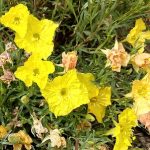
- Lavender Leaf Sundrops
- 3
- Sun
- 10" x 24"
- SW US


Cheerful and long-blooming, this mounding perennial lightens up the summer garden.
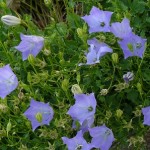
Carpathian Harebells is a more compact version of our native harebells, with larger flowers and a later bloom time. Charming! Firewise.
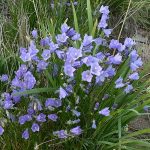
Harebells is a lovely little wildflower is a native to most of the U.S., including Idaho. Its nodding blue flowers are held on wiry stems above attractive basal foliage. Great for borders, rock gardens. Pollinators: native bees. Firewise.
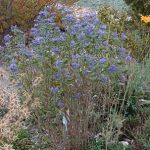
Fast growing upright deciduous shrubby perennial with silvery foliage and lush fall display of delicate blue flowers. Bees love it! Firewise.
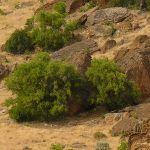
Hackberry is a deciduous native tree, growing on rocky outcroppings on dry slopes in Southern Idaho. Often gnarly, graceful and sculptural in form. Great tree for small areas; berries loved by birds; Native Americans crushed and ate the fruit with parched corn. Firewise.
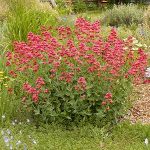
Jupiter’s Beard produces masses of crimson flowers fading to pink from late spring right through the summer. Periodic deadheading will enhance the bloom even more. Attracts Swallowtails and Monarchs. Can seed out somewhat aggressively. Firewise.
Easy, reliable.
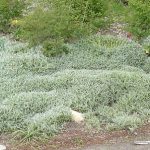
Snow-in-Summer is a lovely evergreen groundcover, attractive even in winter. The fine silvery foliage is covered with masses of white blooms in late spring. No pruning necessary, but faded flowers may be sheared. Firewise.
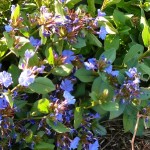
Valuable as a shade-tolerant groundcover, Plumbago will also grow in full sun. Glossy deep green leaves and lovely blue flowers with striking red calyces make this a most attractive spreading groundcover. The plant vanishes in winter, but comes back reliably each spring.
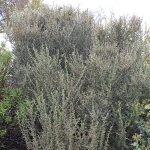
This short, relatively compact shrub is closely related to Curleaf Mountain Mahogany, Fairly slow-growing and evergreen. More information here.
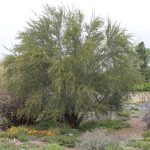
Mountain Mahogany is an attractive evergreen, large shrub to small tree with spreading open crown of thick, twisted branches and furrowed reddish brown bark This beautiful Owyhee County native will tolerate heavy pruning and is browsed into beautiful bonsai-like shapes in the wild. Firewise. More information here.
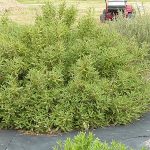
Fernbrush is a multi-stemmed native shrub to small tree with red, shredding bark. Fragrant fern-like foliage and white clusters of rose-like flowers in mid-summer. Adaptable to many soil types and requires little or no additional moisture once established. More information here.
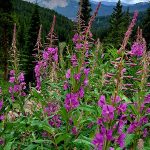
This beauty of the Idaho mountains can live in a garden, but may spread aggressively.
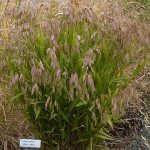
Northern Sea Oats’ upright bamboo-like foliage produces unique drooping, flat panicles or seed-heads. The foliage turns a beautiful bronze in the fall and remains highly ornamental throughout winter. Seed heads are great for dried bouquets.
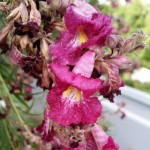
Desert Willow is a small tree with willow-like leaves and gorgeous iris-like flowers in mid-late summer. Attracts Hummingbirds! Tolerates clay. More information here.
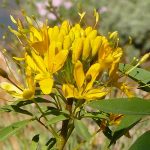
Yellow Bee Plant is a smaller cousin of the purple Rocky Mountain Bee plant, Both of these annuals are extremely valuable as food sources for native bees and butterflies as well as honeybees. Very long-blooming and freely reseeding in the garden. Available spring only.
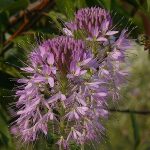
This outstanding native annual is a magnet for honey bees and native bees alike! Tall stalks end in multiple flowers that look as if they were designed by Dr. Seuss. Once it starts blooming in early to mid-summer, Rocky Mountain Bee Plant just keeps going until fall. More information here.
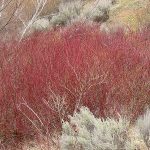
The stems of Red Twig Dogwood (Red Osier Dogwood) turn brilliant red in the fall and are gorgeous all winter. Turning back to green in the spring, the shrub leafs out and then produces clumps of small white blossoms that are popular with pollinators. Tolerates a range of conditions. Can be pruned for shape. Nectar and pollen source for native bees and butterflies. More information here.
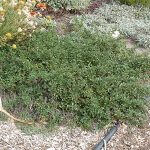
Prostrate evergreen groundcover, good substitute for native Bearberry or Kinnick-kinnick. White flowers in summer are followed by bright red berries persisting into winter. Firewise.
Deciduous upright shrub or small tree usually with thorns, dense, good bird habitat, white flowers in spring, intense red color in fall. 10-15′ tall.
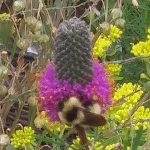
Purple Prairie Clover produces lovely purple bottle-brushes on erect stems. Perfect specimen plant or as part of a meadow or prairie planting. Long-lived, with a deep taproot. Often found on eroded, depleted soils, including caliche. Supports bees and butterflies and fixes nitrogen.

Low carpet of semi-evergreen foliage topped with shocking salmon-colored flowers in late spring. Wonderful addition to any rock garden. Firewise.
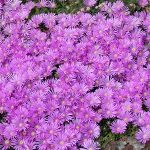
When this Iceplant is in bloom, the shiny lavender flowers practically knock your eyeballs out! Vigorous and hardy. Firewise.
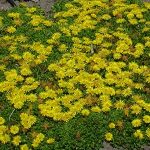
Hardy Iceplant is a fast-growing, mat-forming succulent, lovely garden accent. Bright yellow daisy-like flowers appear in late- spring. fall. Bright-green knobby leaves turn bright red during the winter. Avoid overwatering and excessive winter moisture. Firewise.
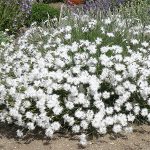
Sand Pink forms large hummocks packed with narrow evergreen foliage. In late spring it is covered with extremely fragrant little white flowers like snowflakes. Attracts butterflies. Firewise.
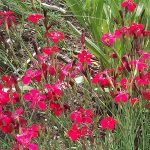
‘Flashing Lights’ Dianthus (Pink): This evergreen dianthus is not pink, but a deep, brilliant red. The mound of narrow, dark green, grassy leaves is attractive year-round. Great for low edging at the front edge of a bed or in a rock garden. Attracts butterflies. Firewise.
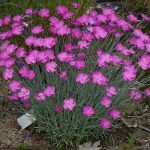
‘Firewitch’ Dianthus (Pink) is a bouquet of electric magenta flowers with frilly edges over a mound of attractive gray-green foliage. Excellent rock garden plant, or use at the front of a border. Attracts butterflies. Firewise.
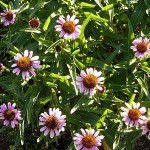
This tap-rooted perennial is found in open, dry prairies of the Midwest, and is prized for its medicinal value. It is also highly ornamental, with lovely purple coneflowers floating above narrow-leaved stalks. Good nectar plant for butterflies and bees.
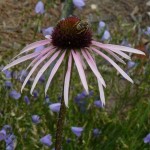
Thin purple petals of this Conflower drape delicately from a bold brown center. It is lovely in a bouquet and also great for naturalizing en masse in the garden. Its deep taproot allows it to thrive in dry soils. Nectar plant for Monarch and other butterflies. Tolerates clay. Pollinators: bees, butterflies.
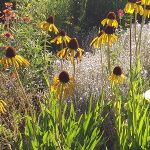
This is the only Coneflower with yellow rather than purple flowers. Its drooping yellow petals surround large, coppery-brown cones. Nectar plant for Monarch and other butterflies. Tolerates clay.
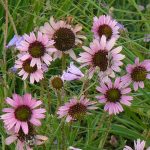
Shorter than other Echinaceas, Tennessee Coneflower cheerfully faces the rising sun and blooms like crazy–even despite heat and low water. Native to dry, rocky areas in Tennessee, it does well in the Intermountain West.
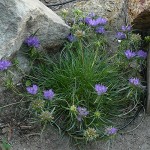
Grassy Bells, an ideal rock garden plant with small tufts of grassy leaves covered in bell-like flowers. The blossoms are violet-blue, on short, outspreading stems. Perfect for edging or containers.
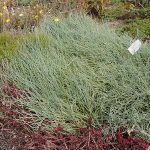
This is the prostrate form of the native Mormon Tea shrub. Thin stems intertwine on the ground to gradually form a thick, sprawling, evergreen groundcover. In mid-summer dozens of bright red berry-like flowers appear, nestled down in the foliage. From Tibet, rare.
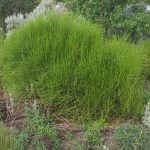
Mormon Tea is an evergreen shrub is native to the high desert of Nevada, Utah and other western states. The bare green stems are marked by the tiny brown ridges which are actually the plant’s leaves. Tolerates clay. Dramatic! Firewise.
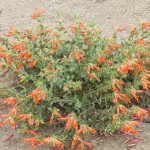
The red tubular flowers are a magnet for Hummers in the late summer and early autumn, as these tiny birds prepare for their annual migration. Adaptable to many soil types and low water, Hummingbird Trumpet provides a spectacular splash of color in the late season garden.
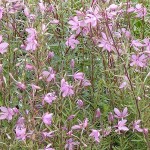
This is a miniature European version of our beautiful native Fireweed. We have been reluctant to offer Fireweed itself as it can be very invasive. Alpine Willowherb is much smaller and promises to be better behaved in the garden. Supports honeybees.
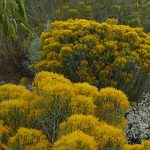
Rubber Rabbitbrush is a tough native shrub covered with brilliant display of golden flowers in fall. Its upright form and graceful silver foliage make it an ideal foundation plant in the xeric garden. Supports butterflies & birds. Needs good drainage. Pollinators: butterflies, small bees. . More info here.
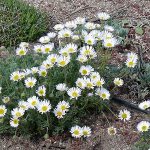
Cutleaf Daisy is a vigorous, long-blooming native Fleabane with dissected leaves and bundles of charming white flowers. Excellent for rock gardens or exposed slopes with good drainage.
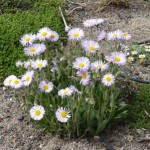
Beautiful Fleabane is a low-growing, early-blooming native daisy. Forms ever-widening patches over the years. Cheerful purple flowers attract pollinators.
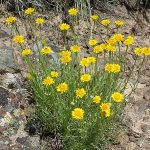
Desert Yellow Fleabane is a small native daisy with cheerful yellow flowers in summer. Grows in poor soil with little care.
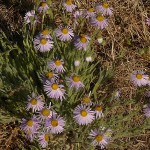
Cheerful little Shaggy Fleabane (Shaggy Daisy) is native to the Boise Foothills. It will survive without additional water, but will flower much more vigorously if given a bit of extra moisture.